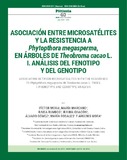| dc.rights.license | http://creativecommons.org/licenses/by-nc-sa/3.0/ve/ | |
| dc.contributor.author | Mora, Víctor | |
| dc.contributor.author | Marcano, María | |
| dc.contributor.author | Rumbos, Raisa | |
| dc.contributor.author | Chacón, Iraima | |
| dc.contributor.author | Gómez, Álvaro | |
| dc.contributor.author | Rosales, María | |
| dc.contributor.author | Mora, Argenis | |
| dc.date.accessioned | 2016-10-27T19:37:24Z | |
| dc.date.available | 2016-10-27T19:37:24Z | |
| dc.date.issued | 2016-01 | |
| dc.identifier.issn | 0554-2111 | |
| dc.identifier.uri | http://www.saber.ula.ve/handle/123456789/42587 | |
| dc.description.abstract | El cacao venezolano, reconocido a nivel mundial por sus excelentes cualidades aromáticas
procedentes del cacao tipo criollo, es considerado también el más sensible a plagas y
enfermedades. una de las enfermedades que afectan a las plantaciones de cacao en la zona Sur del
Lago de Maracaibo, es la “Mancha de agua”, causada por Phytophthora megasperma dreschler, que
ocasiona sobre los frutos una mancha de color marrón claro, de bordes regulares concéntricos que
puede llegar a cubrir toda la mazorca, y afectar a las semillas. en este trabajo, 68 árboles de
cacao de las colecciones vivas del inia y de coRpozulia, fueron caracterizados mediante 23
marcadores microsatélite y evaluados en su respuesta ante P. megasperma. De estos árboles,
fueron desprendidas mazorcas en madurez fisiológica, inoculadas mediante aspersión de gotas
finas, con 1x105 zoosporas/ml y mantenidas por cuatro días a 26ºc, en cámara húmeda y oscuridad.
se evaluó el nivel de resistencia de cada individuo, según una escala cualitativa, en un rango
del 1 (altamente resistente) al 8 (altamente susceptible), considerando presencia, tamaño y
características de las lesiones observadas. la prueba para datos no paramétricos de Kruskal y
Wallis reveló variabilidad en los niveles de resistencia a P. megasperma, confirmando su
naturaleza poligénica, en las plantas evaluadas. el análisis del adn reveló genotipos, desde
criollos homocigotas, hasta Forasteros homocigotas. la respuesta de resistencia fue variable en
cultivares heterocigotas, mostrando 10 árboles alta resistencia e igualmente fue variable en
criollos homocigotas, mostrando dos de ellos alta resistencia al patógeno. | es_VE |
| dc.rights | info:eu-repo/semantics/openAccess | |
| dc.subject | Cacao criollo | es_VE |
| dc.subject | Phytophthora megasperma | es_VE |
| dc.subject | Resistencia | es_VE |
| dc.subject | Microsatélites | es_VE |
| dc.title | Asociación entre microsatélites y la resistencia a Phytopthora megasperma, en árboles de Theobroma cacao L. I. Análisis del fenotipo y del genotipo. | es_VE |
| dc.title.alternative | Association between microsatellites with the resistance to Phytophthora megasperma in Theobroma cacao L. Trees. I. Phenotype and genotype analysis. | es_VE |
| dc.type | info:eu-repo/semantics/article | |
| dc.description.abstract1 | The venezuelan cocoa recognized worldwide for its excellent aromatic qualities, is derived from
the criollo cultivars, which also happen to be highly susceptible to pests and diseases. among
the diseases that affect the Criollo cocoa plantations of the South of the Maracaibo Lake, is
the “Mancha de Agua” caused by Phytophthora megasperma dreschler. this pathogen develops on the
fruits light brown concentric lesions with defined borders, which it may penetrate in the inner
tissues damaging the cocoa seeds. The present research involved 68 trees, belonging to the
collections of inia and coRpozulia; these were characterized using 23 microsatellite markers and
tested for resistance to P. megasperma. physiologically mature pods from the selected trees were
detached and inoculated by spraying fine drops containing 1x105zoospores/ml and kept four days
at 26ºc, in a humid chamber in complete darkness. the level of resistance was evaluated in each
individual according to a qualitative scale, which ranged from 1 (highly resistant) to 8 (highly
susceptible), considering presence, size and characteristics of the lesions. all of the results
were analyzed by the Kruskal-Wallis test for Non Parametric data. Our results revealed an
important variability, confirming the polygenic nature of the resistance to P.megasperma in
evaluated plants. the dna analysis revealed a broad range of diversity; ranging from homozygous
criollo, to homozygous Forastero genotypes. Resistance levels were highly variable in the
heterocigote cultivars, of which 10 cultivars resulted highly resistant; whereas in the criollo
homozygous trees, only two of them proved to be resistant. | es_VE |
| dc.description.colacion | 144 - 163 | es_VE |
| dc.description.email | marseg@ula.ve | es_VE |
| dc.description.frecuencia | Anual | |
| dc.identifier.depositolegal | 196702ME558 | |
| dc.publisher.pais | Venezuela | es_VE |
| dc.subject.departamento | Departamento de Botánica | es_VE |
| dc.subject.facultad | Facultad de Ciencias Forestales y Ambientales | es_VE |
| dc.subject.institucion | Universidad de Los Andes (ULA) | es_VE |
| dc.subject.keywords | Criollo cacao | es_VE |
| dc.subject.keywords | Phytophthora megasperma | es_VE |
| dc.subject.keywords | Resistance | es_VE |
| dc.subject.keywords | Microsatellites | es_VE |
| dc.subject.publicacionelectronica | Pittieria | |
| dc.subject.seccion | Pittieria: Artículos | es_VE |
| dc.subject.thematiccategory | Medio Ambiente | es_VE |
| dc.subject.tipo | Revistas | es_VE |
| dc.type.media | Texto | es_VE |


